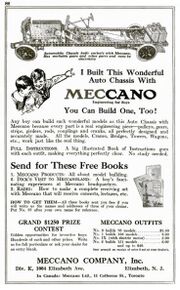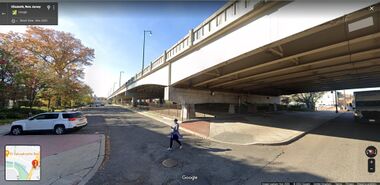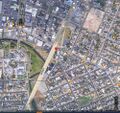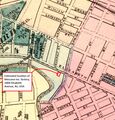Category:1004 Elizabeth Avenue, Elizabeth, NJ
Meccano/Hornby/Dinky :
Mechanics Made Easy | Meccano | Super Models | Motor Car Constructor | Aeroplane Constructor | Dinky Builder | X-Series | Plastic
W UK US FR DE 1900s | 1910s | 1920s | 1930s | 1940s | 1950s | 1960s | 1970s |
1922 Meccano US advert [image info]
1104 Elizabeth Avenue, Elizabeth, NJ (estimated)
[image info]
1104 Elizabeth Avenue, Elizabeth, NJ (Google Maps) [image info]
1004 Elizabeth Avenue (Google Streetview) [image info]
Numbers 1000 to 1002 Elizabeth Avenue (Google Streetview) [image info]
the Route 1 Extension (wikipedia) [image info]
Meccano's American factory in Elizabeth, New Jersey was acquired by 1922, but other than a publicity image, we don't seem to know much about it or what happened to it. We know that the "Elizabeth" location is referred in 1922 literature, but it's replaced by an address in Connecticut in the 1930s, and the usual narratives says that after Gilbert acquired the Meccano Company Inc., they shut down the factory and moved production to their main location.
This leaves us with something of a mystery. Who took over the factory space? Did it become a Gilbert-owned building? Why is it difficult to find a record of some other business inheriting the factory at number 1004 after 1929?
Below is what we've been able to find out so far.
The building
A little while ago we purchased a very fine factory in the town of Elizabeth, New Jersey. This is a splendidly equipped building and might almost have been planned specifically for our purpose. There will be no difficulty, therefore, in the future in properly attending to the assembling and distribution of Meccano throughout America from there. On this page you will find a picture of our new building, giving some idea of its size and importance. It has a floor space of over 36500 square feet, is well lighted and heated and has beautiful maple floors. The building is about an hour's run from New York by train and has excellent facilities and conveniences for distributing our goods to all parts of the country.
— , Frank Hornby, , Meccano Magazine, , March 1922
Address
Even finding the exact address of the site is difficult, but an advert from 1922 lists Meccano's address as 1004 Elizabeth Avenue, Elizabeth, New Jersey.
Location
The northern part of New Jersey is approximately to the SouthWest of New York City, and its flat crenellated coastline with inlets and rivers makes it a typical port or dockland area, full of industrial units.
1004 Elizabeth Avenue is placed by Google Maps on the southwest side of Elizabeth Avenue, and lines up with the straighter, more northerly part of Spring Street. The plot backs onto a winding part of the Elizabeth River, where there were facilities for loading and unloading goods and materials for transport by boat.
So Elizabeth Avenue gave the site access to industrial dockspace, the back of the site gave it access directly to the river, and the roads at right angles to Elizabeth Anue, like Spring Street, pointed directly towards Manhattan Island. Geographically, the factory's location probably seemed superb.
Elizabeth NJ history, circa 1929-1930, and Interstate Number One
At the beginning of the C20th, federal planners had established the need for a new set of interstate highways to further unite the country, help industry to move goods and raw materials from state to state, and to allow easier military mobilisation in times of war. These new futuristic highways wouldn't be designed like conventional roads, they'd be engineered like railway lines, with long straight sections, very wide-radius curves and gradual inclines. The designers were told not to think of the capabilities of cars when designing the new network, they were to visualise the moving traffic as if it was a set of freight trains, with continuous uninterrupted flow, running over concrete rather than rails. Junctions would be avoided wherever possible, and the new superhighways would make extensive use of embankments, flyovers, and where necessary, tunnels in order to keep the traffic moving.
The flagship of the new network was going to be the Route 1 (US 1) extension linking New York and New Jersey, and connecting to the impending Holland Tunnel under the Hudson River (originally to be the Hudson River Vehicular Tunnel), which would connect Manhattan Island with the Hudson's Western shoreline. With work on the Holland Tunnel starting in 1920, and the Tunnel opening in 1927, it obviously made sense for there to be a sleek new section of redesigned roadway for the new tunnel to connect to.
This redesign of Route 1 to Manhattan replaced a circuitous and awkward route that had a number of right-angled turns at crossroads with a new section of roadway that didn't skirt around Elizabeth, but went straight through it, as the country's first section of "superhighway". The extension seems to have been decided on in 1922 and the route finalised in 1923. There were three main sections of the extension, the Pulaski Skyway, which took traffic from the planned Holland Tunnel linking to Manhattan, a second set of flyovers that skirted around New Jersey airport, and a third section which cut through the middle of Elizabeth. Contemporary discussions tended to fixate on the idea of a route to the East of Spring Street, that then curved round to hit the Elizabeth River, and would involve the compulsory purchase and destruction of a fair amount of domestic property. One has to assume that when Frank Hornby bought the site, he would have been reassured (if he even knew about the development) that it would be taking this more Eastern route.
In the event, it didn't. Instead the planners decided to override objections about widening Spring Street, and take the new multi-lane highway straight down Spring Street, and then take it across a zig-zagging region of Elizabeth River, which was, of course, not built on. Other than the properties along the sides of Spring Street, the new plan only needed to trash the plots of land between Spring Street and the river ... which is where we think 1004 was.
The southern part of the Route 1 extension is reckoned to have been finished in 1930, which suggests that construction would probably have been well underway or at least ready to start in 1929, which was when Hornby sold the business.
So it would seem that Frank Hornby's precious factory was probabably partly or completely destroyed (or at the very least, the site compromised) in 1929/1930 to make way for the Interstate Highway Extension Number One.
Caveats
It's always dangerous to put too much faith in online information that's often incomplete and sometimes faulty - for instance, might the advert have contained a typo-ed address? Might the address refer to a separate office address rather than the address of the factory? Did the construction of the bridge alter the road numbering? Currently, Number 1004 points to a site right alongside the bridge, which we are assuming represents part of the remnants of the original plot that the bridge now cuts through, and that the factory was under the current bridge location.
To check this, we looked up the locations of the current businesses at 1000, 1001 and 1002 Elizabeth Avenue, shown in the streetview snap: 1000 (left) is an agency, 1001 is a broker's and 1002 (centre) is Alfredo's Barber Shop. 1003 and 1004 appear to have been demolished. We think that 1003 would probably have been similar in width to 1000, after which we'd have had the large plot of land with the big factory, of 1004, which would have to be at least partially intersecting the current bridge location (right).
Another complication is that the bridge shown on the satellite imagery and on Google Streetview is not the structure built in 1930, but the revised, wider version of the viaduct that started to be rebuilt in 2004, so althrough the current viaduct obliterates a large chunk of land where we'd expect to see Number 1004, the original narrower bridge might have been less damaging to the site.
Verdict
Most histories simply assume that Hornby's American adventure fell foul of economics: Hornby may have expected to receive the same sort of response in the States that he had gotten in the UK and Europe, but in the US, respect for the tradition of the Great American Inventor played into the marketing strategy of A.C. Gilbert, a charismatic figure and brilliant marketer who'd represented the US at the Olympics, and had his own metal construction system, Erector.
Others have pointed out the fact of the American Great Depression, triggered by the Wall Street Crash of 1929 ... and yes, Hornby did sell the business in '29. But in '29, people didn't really know how long the misery was going to last for, and other toy companies (such as Gilbert) survived it.
It's conceivable that either or both of these things might have been enough to wreck Hornby's plans. However, a more mundane potential reason for the closure of the factory seems to be that 1929 was the year that work started on building the Elizabeth viaduct carrying Interstate 1 across the Elizabeth River, and the bridge, finished in 1930, seems to have gone straight through Hornby's factory. We can also note that the time that the authorities finally signed off on going ahead with the extension -- 1922 -- seems to have been around the same time that the factory's previous owner sold it to Hornby. Hornby may have suspected that -- as the foreigner ignorant of local politics -- he might have been conned into buying a factory whose wonderful location was just too good, and that perhaps the seller might have suspected that the site might be liable to compulsory purchase and demolition a few years down the line.
External links
Media in category ‘1004 Elizabeth Avenue, Elizabeth, NJ’
The following 6 files are in this category, out of 6 total.
- 1000-1002 Elizabeth Avenue, Elizabeth, NJ (Google Streetview).jpg 1,542 × 660; 250 KB
- 1004 Elizabeth Avenue, Elizabeth, NJ (Google Aerial).jpg 999 × 937; 406 KB
- 1004 Elizabeth Avenue, Elizabeth, NJ (Google Streetview).jpg 1,920 × 936; 350 KB
- Meccano Inc, 1004 Elizabeth Avenue, Elizabeth NJ.jpg 1,845 × 1,923; 641 KB
- Meccano US Free Books (PS 1922-10).jpg 368 × 593; 67 KB
- The New Meccano Building, Elizabeth NJ USA (MM 1922-03).jpg 1,250 × 831; 154 KB
















